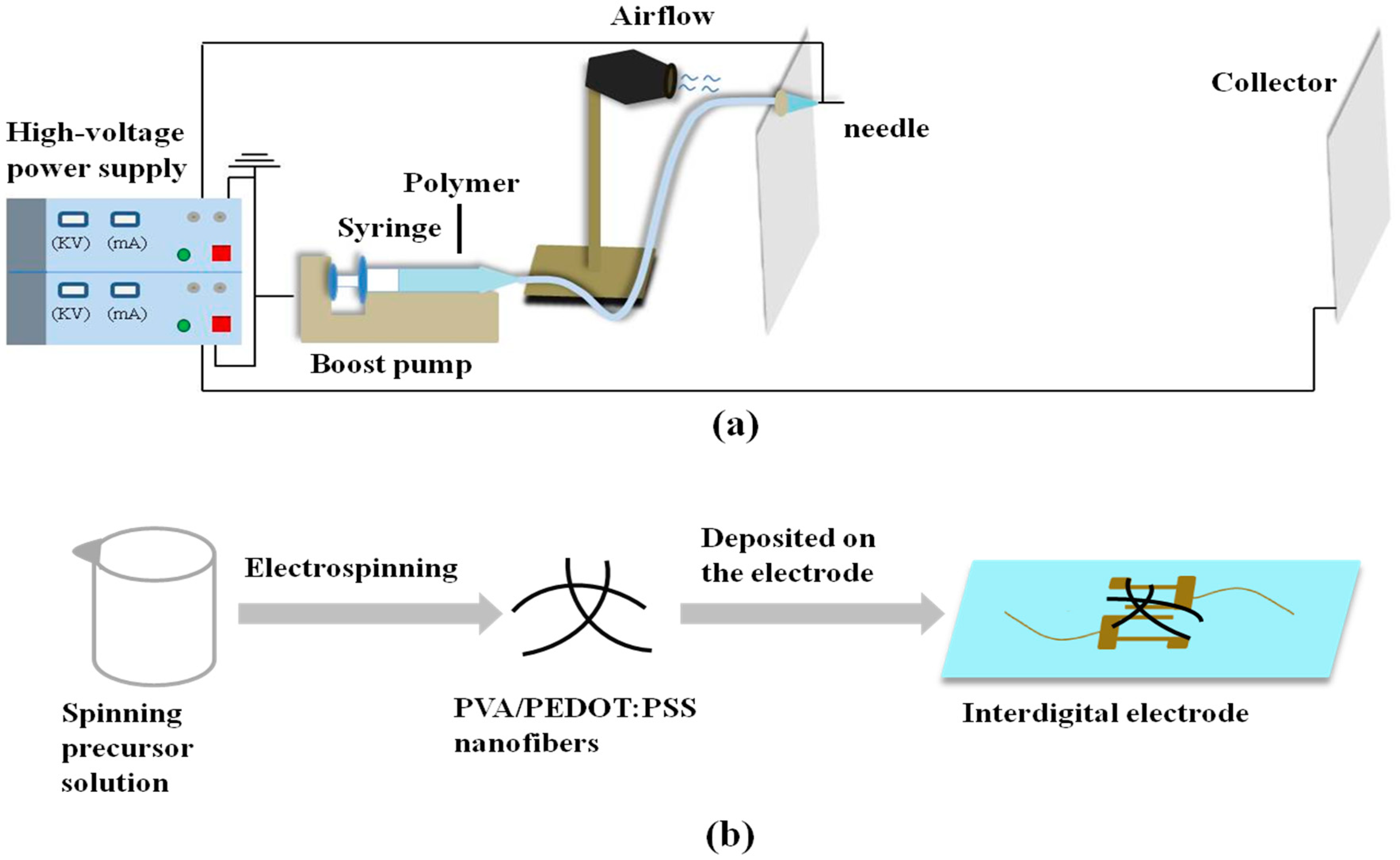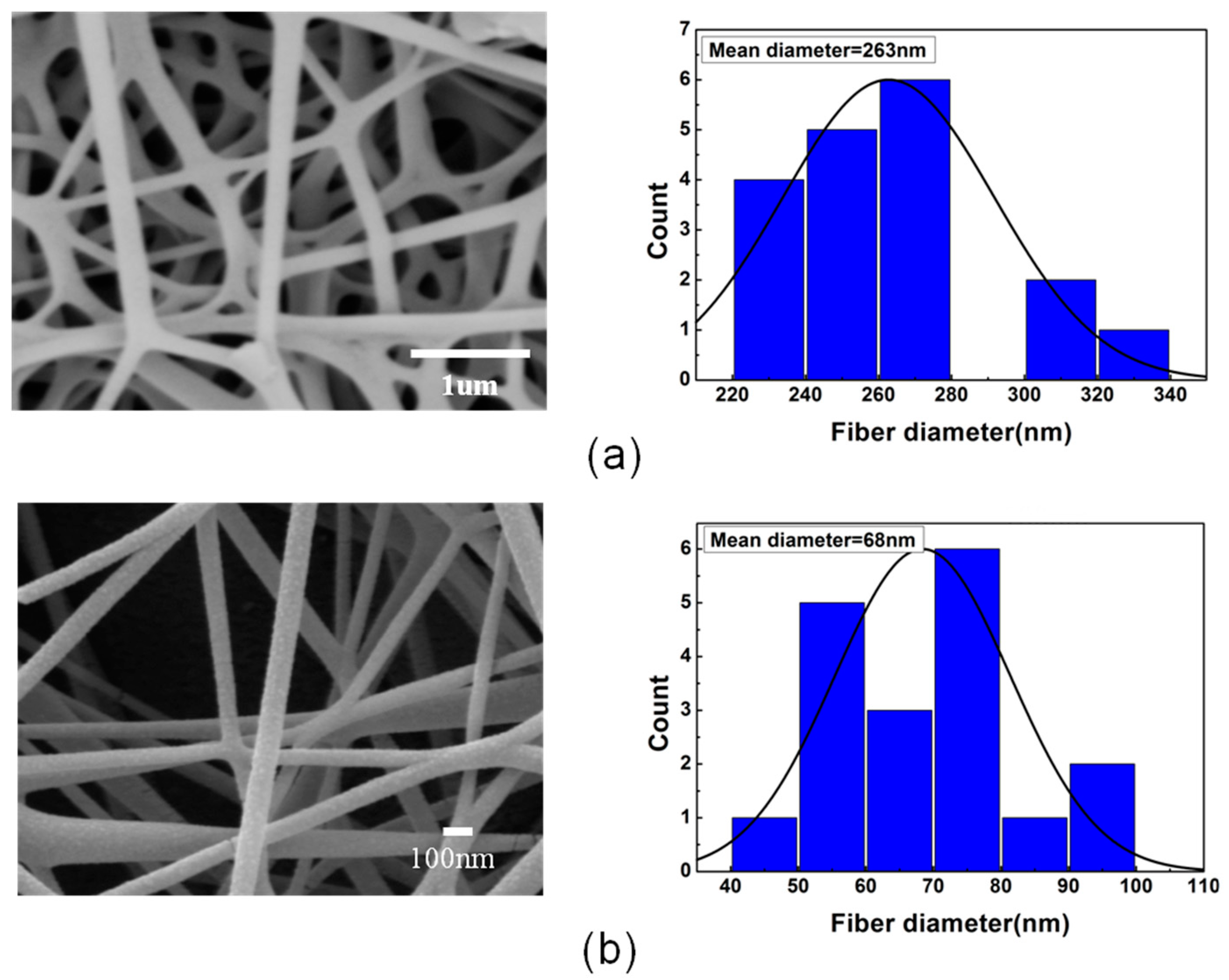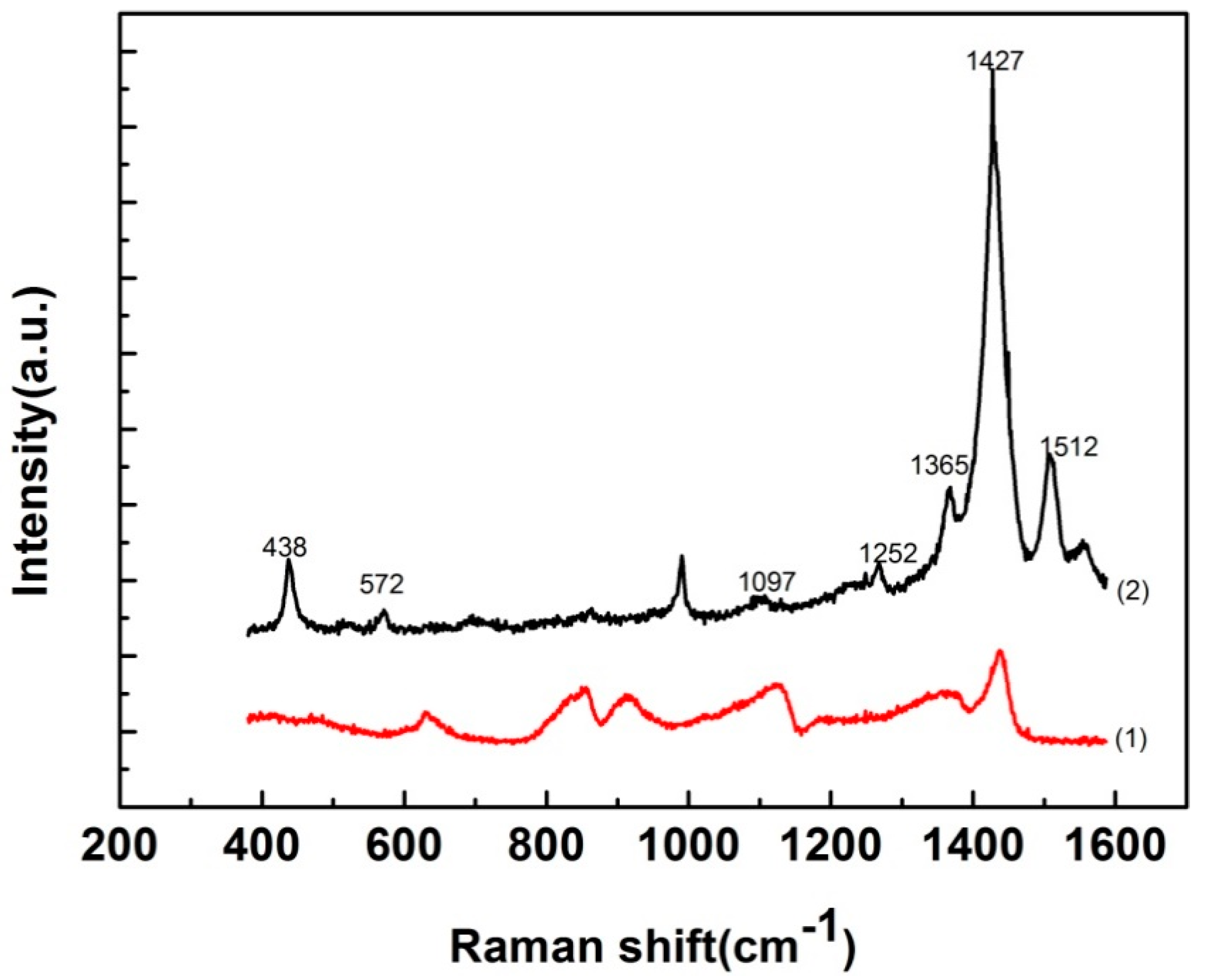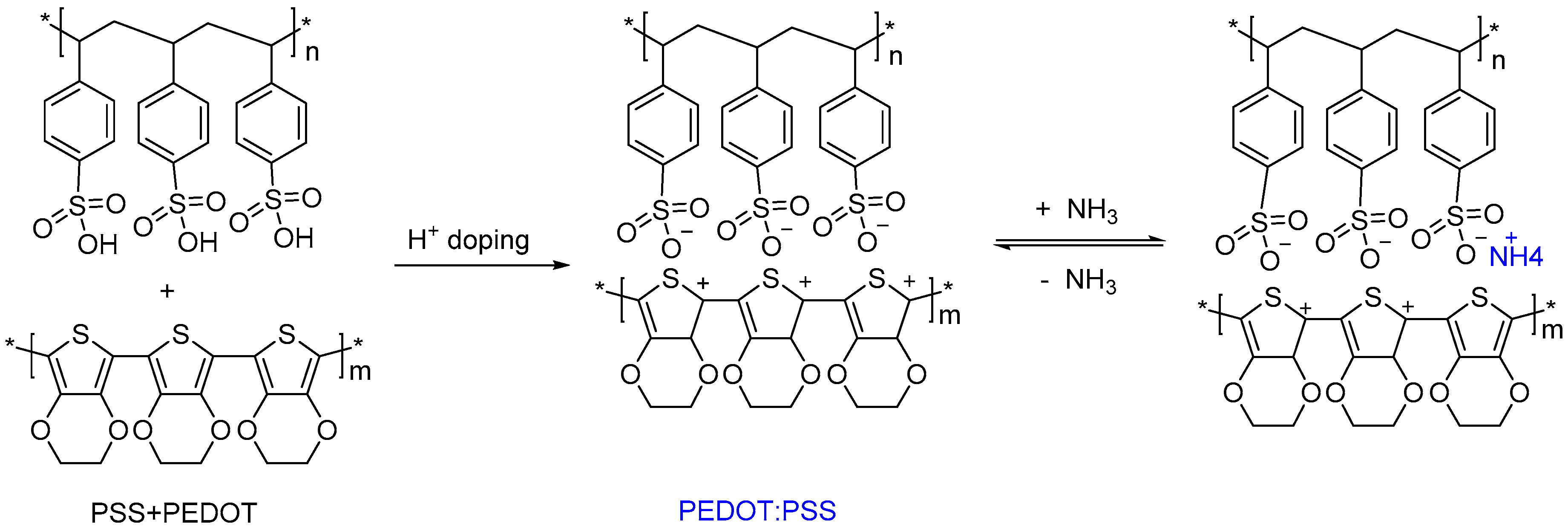Electrospinning of Ultrafine Conducting Polymer Composite Nanofibers with Diameter Less than 70 nm as High Sensitive Gas Sensor
Abstract
:1. Introduction
2. Experimental Section
2.1. Materials and Methods
2.2. Preparation of PVA/PEDOT:PSS Ultrafine Nanofibers
3. Results and Discussion
3.1. Characterization of Morphology and Structures
3.2. Raman Spectrum Analysis
3.3. Electrical and Gas Sensing Measurement
4. Conclusions
Author Contributions
Funding
Conflicts of Interest
References
- Huang, C.; Chen, S.; Lai, C.; Reneker, D.H.; Qiu, H.; Ye, Y.; Hou, H. Electrospun polymer nanofibres with small diameters. Nanotechnology 2006, 17, 1558–1563. [Google Scholar] [CrossRef] [PubMed]
- Hou, H.; Jun, Z.; Reuning, A.; Schaper, A.; Wendorff, J.H.; Greiner, A. Poly(p-xylylene) nanotubes by coating and removal of ultrathin polymer template fibers. Macromolecules 2002, 35, 2429–2431. [Google Scholar] [CrossRef]
- de Gramont, F.B.; Zhang, S.M.; Tomasello, G.; Kumar, P.; Sarkissian, A.; Cicoira, F. Highly stretchable electrospun conducting polymer nanofibers. Appl. Phys. Lett. 2017, 111, 093701. [Google Scholar] [CrossRef]
- Bergshoef, M.M.; Vancso, G.J. Transparent nanocomposites with ultrathin, electrospun nylon-4,6 fiber reinforcement. Adv. Mater. 1999, 11, 1362–1365. [Google Scholar] [CrossRef]
- Long, Y.Z.; Li, M.M.; Gu, C.; Wan, M.; Duvail, J.L.; Liu, Z.; Fan, Z. Recent advances in synthesis, physical properties and applications of conducting polymer nanotubes and nanofibers. Prog. Polym. Sci. 2011, 36, 1415–1442. [Google Scholar] [CrossRef]
- He, J.H.; Wan, Y.Q.; Xu, L. Nano-effects, quantum-like properties in electrospun nanofibers. Chaos. Soliton Fract. 2007, 33, 26–37. [Google Scholar] [CrossRef]
- Wong, S.C.; Baji, A.; Leng, S. Effect of fiber diameter on tensile properties of electrospun poly(ɛ-caprolactone). Polymer 2008, 49, 4713–4722. [Google Scholar] [CrossRef]
- Cai, Z.; Martin, C.R. Electronically conductive polymer fibers with mesoscopic diameters show enhanced electronic conductivities. J. Am. Chem. Soc. 1989, 111, 4138–4139. [Google Scholar] [CrossRef]
- Wu, R.J.; Huang, Y.C.; Chavali, M.; Lin, T.H.; Hung, S.L.; Luk, H.N. New sensing technology for detection of the common inhalational anesthetic agent sevoflurane using conducting polypyrrole films. Sensor Actuat. B Chem. 2007, 126, 387–393. [Google Scholar] [CrossRef]
- Chang, J.B.; Liu, V.; Subramanian, V.; Sivula, K.; Luscombe, C.; Murphy, A.; Fréchet, J.M. Printable polythiophene gas sensor array for low-cost electronic noses. J. Appl. Phys. 2006, 100, 014506. [Google Scholar] [CrossRef]
- Virji, S.; Huang, J.; Kaner, R.B.; Weiller, B.H. Polyaniline nanofiber gas sensors: Examination of response mechanisms. Nano Lett. 2004, 4, 491–496. [Google Scholar] [CrossRef]
- Long, Y.; Chen, Z.; Wang, N.; Ma, Y.; Zhang, Z.; Zhang, L.; Wan, M. Electrical conductivity of a single conducting polyaniline nanotube. Appl. Phys. Lett. 2003, 83, 1863–1865. [Google Scholar] [CrossRef]
- Zhang, H.D.; Tang, C.C.; Long, Y.Z.; Zhang, J.C.; Huang, R.; Li, J.J.; Gu, C.Z. High-sensitivity gas sensors based on arranged polyaniline/PMMA composite fibers. Sensor Actuat. A Phys. 2014, 219, 123–127. [Google Scholar] [CrossRef]
- Panapoy, M.; Saengsil, M.; Ksapabutr, B. Electrical conductivity of poly(3,4-ethylenedioxythiophene)-poly(styrenesulfonate) coatings on polyacrylonitrile nanofibers for sensor applications. Adv. Mater. Res. 2008, 55, 257–260. [Google Scholar] [CrossRef]
- Zhang, H.D.; Yan, X.; Zhang, Z.H.; Yu, G.F.; Han, W.P.; Zhang, J.C.; Long, Y.Z. Electrospun PEDOT: PSS/PVP nanofibers for CO gas sensing with quartz crystal microbalance technique. Int. J. Polym. Sci. 2016, 3021353. [Google Scholar] [CrossRef]
- Jia, X.S.; Tang, C.C.; Yan, X.; Yu, G.F.; Li, J.T.; Zhang, H.D.; Li, J.J.; Gu, C.Z.; Long, Y.Z. Flexible polyaniline/poly(methyl methacrylate) composite fibers via electrospinning and in situ polymerization for ammonia gas sensing and strain sensing. J. Nanomater. 2016, 9102828. [Google Scholar] [CrossRef]
- Pinto, N.J. Electrospun conducting polymer nanofibers as the active material in sensors and diodes. In Journal of Physics Conference Series, Proceedings of 8th Ibero-American Congress on Sensors (IBERSENSOR), Carolina, PR, USA, 16–19 October 2012; Ramos, I., Santiago Aviles, J.J., Eds.; IOP Publishing Ltd.: Bristol, UK, 2013; Volume 421, p. 012004. [Google Scholar]
- Doustgani, A.; Ahmadi, E. Melt electrospinning process optimization of polylactic acid nanofibers. J. Ind. Text 2016, 45, 626–634. [Google Scholar] [CrossRef]
- Hochleitner, G.; Youssef, A.; Hrynevich, A.; Haigh, J.N.; Jungst, T.; Groll, J.; Dalton, P.D. Fibre pulsing during melt electrospinning writing. BioNanoMaterials 2016, 17, 159–171. [Google Scholar] [CrossRef]
- Aussawasathien, D.; Sahasithiwat, S.; Menbangpung, L. Electrospun camphorsulfonic acid doped poly(o-toluidine)–polystyrene composite fibers: Chemical vapor sensing. Synth. Met. 2008, 158, 259–263. [Google Scholar] [CrossRef]
- Pinto, N.J.; Ramos, I.; Rojas, R.; Wang, P.C.; Jahnson, A.T. Electric response of isolated electrospun polyaniline nanofibers to vapors of aliphatic alcohols. Sensor Actuat. B Chem. 2008, 129, 621–627. [Google Scholar] [CrossRef]
- Kessick, R.; Tepper, G. Electrospun polymer composite fiber arrays for the detection and identification of volatile organic compounds. Sensor Actuat. B Chem. 2015, 117, 205–210. [Google Scholar] [CrossRef]
- Ji, S.; Li, Y.; Yang, M. Gas sensing properties of a composite composed of electrospun poly(methyl methacrylate) nanofibers and in situ polymerized polyaniline. Sensor Actuat. B Chem. 2008, 133, 644–649. [Google Scholar] [CrossRef]
- Wang, X.F.; Ding, B.; Sun, M.; Yu, J.; Sun, G. Nanofibrous polyethyleneimine membranes as sensitive coatings for quartz crystal microbalance-based formaldehyde sensors. Sensor Actuat. B Chem. 2010, 144, 11–17. [Google Scholar] [CrossRef]
- Wu, X.F.; Dzenis, Y.A. Size effect in polymer nanofibers under tension. J. Appl. Phys. 2007, 102, 044306. [Google Scholar] [CrossRef] [Green Version]
- Memarzadeh, R.; Noh, H.B.; Javadpour, S.; Panahi, F.; Feizpour, A.; Shim, Y.B. Carbon monoxide sensor based on a B2HDDT-doped PEDOT:PSS layer. Bull. Kor. Chem. Soc. 2013, 34, 2291–2296. [Google Scholar] [CrossRef]
- Badr, Y.A.; Abd El-Kader, K.M.; Khafagy, R.M. Raman spectroscopic study of CdS/PVA composite films. J. Appl. Polym. Sci. 2010, 92, 1984–1992. [Google Scholar] [CrossRef]
- Choi, J.; Lee, J.; Choi, J.; Jung, D.; Sang, E.S. Electrospun PEDOT:PSS/PVP nanofibers as the chemiresistor in chemical vapour sensing. Synth. Met. 2010, 160, 1415–1421. [Google Scholar] [CrossRef]
- Schaarschmidt, A.; Farah, A.A.; Aby, A.; Helmy, A.S. Influence of nonadiabatic annealing on the morphology and molecular structure of PEDOT-PSS films. J. Phys. Chem. B 2009, 113, 9352–9355. [Google Scholar] [CrossRef] [PubMed]
- Zhou, Y.; Long, Y.Z.; Chen, Z.J.; Zhang, Z.M.; Wan, M.X. Resistivity of polyaniline nanotube s doped with naphthalene sulfonic acid: Dependence on moisture and ethanol. Acta Phys. Sin. 2005, 54, 228–232. [Google Scholar]
- Kebiche, H.; Debarnot, D.; Merzouki, A.; Poncin-Epaillard, F.; Haddaoui, N. Relationship between ammonia sensing properties of polyaniline nanostructures and their deposition and synthesis methods. Anal. Chim. Acta 2012, 737, 64–71. [Google Scholar] [CrossRef] [PubMed]
- Ding, B.; Kim, J.; Miyazaki, Y.; Shiratori, S. Electrospun nanofibrous membranes coated quartz crystal microbalance as gas sensor for NH3 detection. Sensor Actuat. B Chem. 2004, 101, 373–380. [Google Scholar] [CrossRef]
- Sengupta, P.P.; Kar, P.; Adhikari, B. Influence of dopant in the synthesis, characteristics and ammonia sensing behavior of processable polyaniline. Thin Solid Films 2009, 517, 3770–3775. [Google Scholar] [CrossRef]
- Seekaew, Y.; Lokavee, S.; Phokharatkul, D.; Wisitsoraat, A.; Kerdcharoen, T.; Wongchoosuk, C. Low-cost and flexible printed graphene–PEDOT: PSS gas sensor for ammonia detection. Org. Electron. 2014, 15, 2971–2981. [Google Scholar] [CrossRef]
- Wang, G.; Ji, Y.; Huang, X.; Yang, X.; Gouma, P.I.; Dudley, M. Fabrication and characterization of polycrystalline WO3 nanofibers and their application for ammonia sensing. J. Phys. Chem. B 2006, 110, 23777–23782. [Google Scholar] [CrossRef] [PubMed]
- Xu, J.; Jiang, Y.; Yang, Y.; Yu, J. Self-assembly of conducting polymer nanowires at air–water interface and its application for gas sensors. Mater. Sci. Eng. B 2009, 157, 87–92. [Google Scholar] [CrossRef]
- Verma, D.; Dutta, V. Role of novel microstructure of polyaniline-CSA thin film in ammonia sensing at room temperature. Sensor Actuat. B Chem. 2008, 134, 373–376. [Google Scholar]
- Kwon, O.S.; Park, E.; Kweon, O.Y.; Park, S.J.; Jang, J. Novel flexible chemical gas sensor based on poly(3,4-ethylenedioxythiophene) nanotube membrane. Talanta 2010, 82, 1338–1343. [Google Scholar] [CrossRef] [PubMed]
- Hong, L.; Li, Y.; Yang, M. Fabrication and ammonia gas sensing of palladium/polypyrrole nanocomposite. Sensor Actuat. B Chem. 2010, 145, 25–31. [Google Scholar] [CrossRef]
- Tai, H.; Jiang, Y.; Xie, G.; Yu, J.; Chen, X. Fabrication and gas sensitivity of polyaniline–titanium dioxide nanocomposite thin film. Sensor Actuat. B Chem. 2007, 125, 644–650. [Google Scholar] [CrossRef]







| Materials | Array of Fibers | Diameter | Operating Temperature (°C) | Detection Limit |
|---|---|---|---|---|
| PANI [31] | - | 300 nm | RT | 92 ppm |
| PAA-PVA [32] | Nonwoven | 100–400 nm | RT | 50 ppm |
| PANI [33] | - | - | RT | 100 ppm |
| Graphene/PEDOT:PSS [34] | - | - | RT | 5 ppm |
| WO3 [35] | Nonwoven | 20–140 nm | 350 °C | 50 ppm |
| PEDOT [36] | nanowire | 350 nm | RT | 10 ppm |
| PANI [37] | - | - | RT | 50 ppm |
| PEDOT [38] | nanotube | 140 nm | RT | 5 ppm |
| Palladium/polypyrrole [39] | - | 15–35 nm | RT | 20 ppm |
| PANI/TiO2 [40] | - | - | RT | 23 ppm |
© 2018 by the authors. Licensee MDPI, Basel, Switzerland. This article is an open access article distributed under the terms and conditions of the Creative Commons Attribution (CC BY) license (http://creativecommons.org/licenses/by/4.0/).
Share and Cite
Zhang, Q.; Wang, X.; Fu, J.; Liu, R.; He, H.; Ma, J.; Yu, M.; Ramakrishna, S.; Long, Y. Electrospinning of Ultrafine Conducting Polymer Composite Nanofibers with Diameter Less than 70 nm as High Sensitive Gas Sensor. Materials 2018, 11, 1744. https://doi.org/10.3390/ma11091744
Zhang Q, Wang X, Fu J, Liu R, He H, Ma J, Yu M, Ramakrishna S, Long Y. Electrospinning of Ultrafine Conducting Polymer Composite Nanofibers with Diameter Less than 70 nm as High Sensitive Gas Sensor. Materials. 2018; 11(9):1744. https://doi.org/10.3390/ma11091744
Chicago/Turabian StyleZhang, Qianqian, Xiaoxiong Wang, Jie Fu, Ruiqiang Liu, Hongwei He, Jianwei Ma, Miao Yu, Seeram Ramakrishna, and Yunze Long. 2018. "Electrospinning of Ultrafine Conducting Polymer Composite Nanofibers with Diameter Less than 70 nm as High Sensitive Gas Sensor" Materials 11, no. 9: 1744. https://doi.org/10.3390/ma11091744







